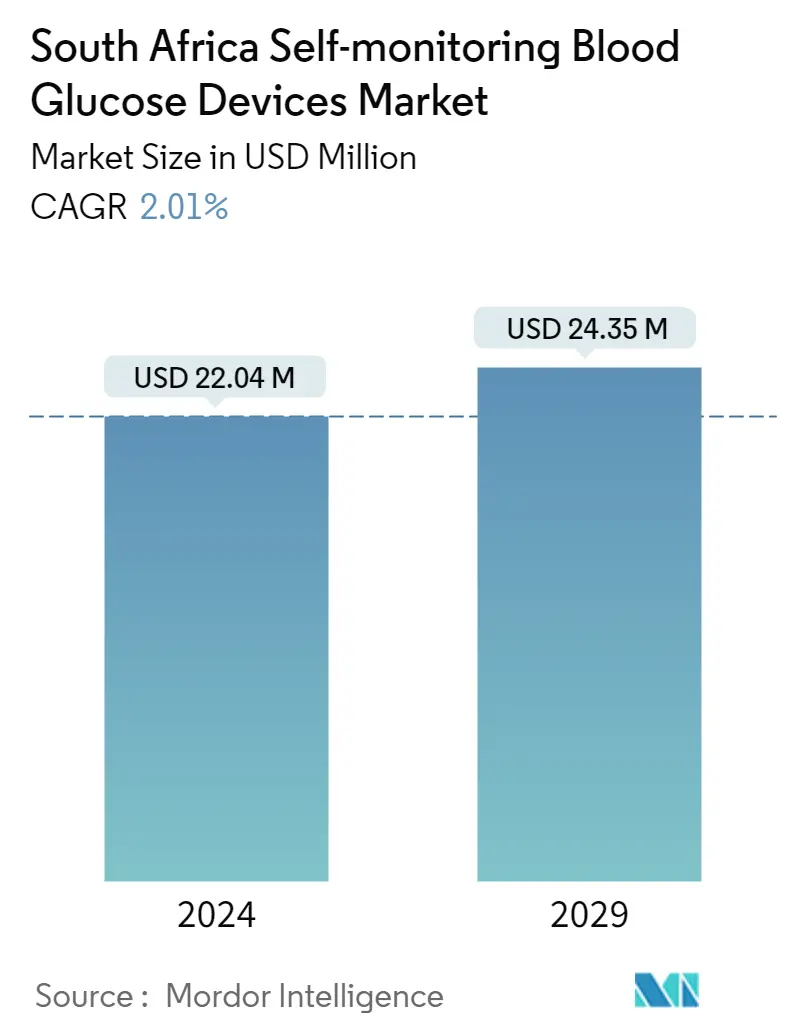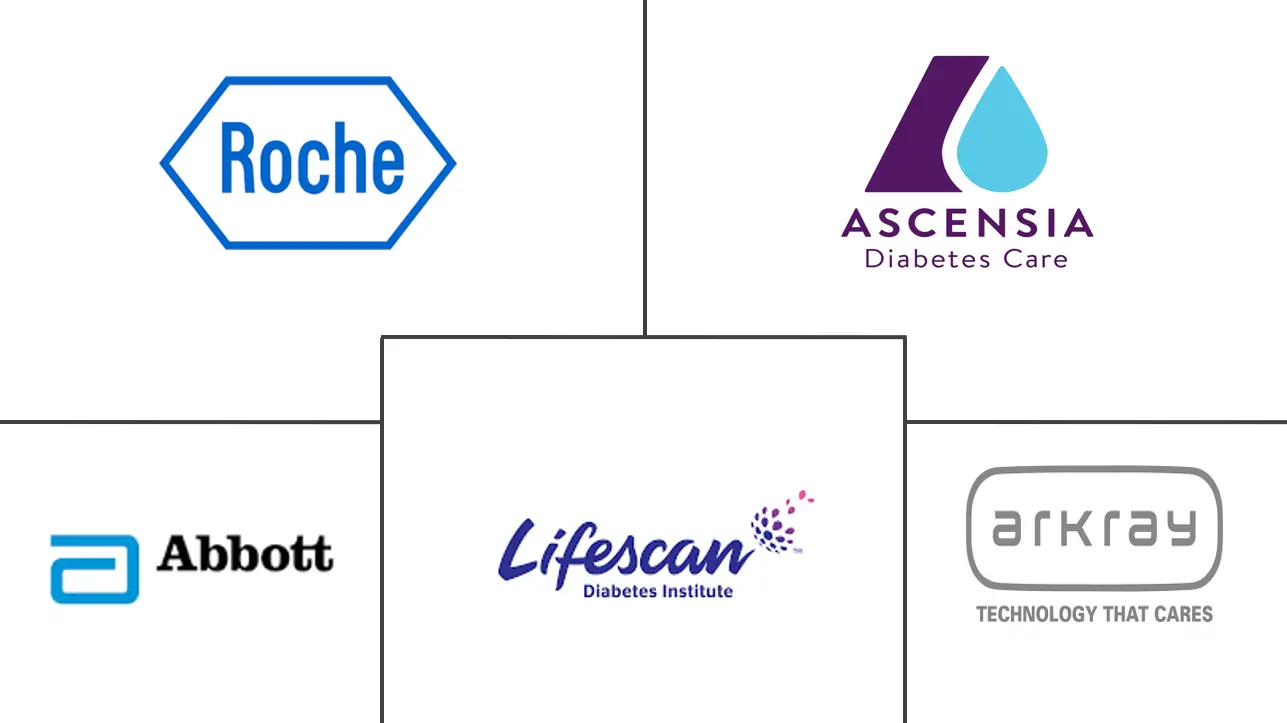Market Size of South Africa Self-monitoring Blood Glucose Devices Industry

| Study Period | 2019 - 2029 |
| Base Year For Estimation | 2023 |
| Forecast Data Period | 2024 - 2029 |
| Market Size (2024) | USD 22.04 Million |
| Market Size (2029) | USD 24.35 Million |
| CAGR (2024 - 2029) | 2.01 % |
Major Players
*Disclaimer: Major Players sorted in no particular order |
South Africa Self-monitoring Blood Glucose Devices Market Analysis
The South Africa Self-monitoring Blood Glucose Devices Market size is estimated at USD 22.04 million in 2024, and is expected to reach USD 24.35 million by 2029, growing at a CAGR of 2.01% during the forecast period (2024-2029).
Patients with diabetes infected with COVID-19 experienced elevated blood glucose, abnormal glucose variability, and diabetic complications. The Western Cape Provincial Health Department's data on COVID-19 fatalities suggested that people with diabetes were more likely to die from COVID-19 than any other high-risk group. The provincial health department estimated that out of every 100 people within the public healthcare sector who died from COVID-19, 52 had diabetes. While new-onset hyperglycemia and new-onset diabetes were increasingly recognized in the context of COVID-19 and were associated with worse outcomes. To avoid aggravation, a patient's blood glucose should be monitored and maintained regularly, which has underlined the importance of diabetes care devices.
According to IDF Diabetes Atlas 2021, one in nine adults in South Africa were living with diabetes. The main diagnosis for diabetes patients was imbalances in blood glucose levels, which are not in compliance with the standard blood glucose levels. The general lab diagnostic tests can only help to diagnose the disease by physicians. Patients with more fluctuations in glucose levels need to get it checked every day. Patients taking insulin need to check their blood glucose levels frequently, adjust the doses of insulin, or change the medication if necessary.
The rate of newly diagnosed type 1 and type 2 diabetes cases is seen to increase, mainly due to obesity, unhealthy diet, and physical inactivity. The rapidly increasing incidence and prevalence of diabetic patients and healthcare expenditure in developed countries are indications of the increasing usage of diabetic care products. Self-blood glucose monitoring allows a patient to check their blood glucose levels as often as they need to or as recommended. Over time, the readings provide the patient and their health professionals with the information required to determine the best management strategy for diabetes. Leading manufacturers are focusing on technological innovations and the development of advanced products to gain a substantial share of the market.
South Africa Self-monitoring Blood Glucose Devices Industry Segmentation
Self-monitoring of blood glucose is an approach used by diabetic patients to measure their blood glucose level themselves, using a glucometer, test strips, and lancets. Based on the readings, patients can adjust or check the effect of their treatment. The South Africa self-monitoring blood glucose devices market is segmented into components (glucometer devices, test strips, lancets). The report offers the value (in USD) and volume (in Units) for the above segments.
South Africa Self-monitoring Blood Glucose Devices Market Size Summary
The South Africa self-monitoring blood glucose devices market is poised for steady growth over the forecast period, driven by the increasing prevalence of diabetes and the rising need for effective diabetes management solutions. The market is characterized by a moderate level of fragmentation, with key players such as Abbott, F. Hoffmann-La Roche AG, and Ascensia holding significant shares. The growing incidence of diabetes, exacerbated by factors like obesity, unhealthy diets, and sedentary lifestyles, underscores the importance of self-monitoring devices. These devices enable patients to regularly check their blood glucose levels, facilitating better management of their condition and improving overall health outcomes. Technological advancements in glucose monitoring are further propelling market growth, as manufacturers focus on developing innovative and user-friendly products.
The South African government's initiatives, such as the implementation of a sugar tax and the launch of the Diabetes Prevention Programme, aim to combat the rising diabetes prevalence by promoting healthier lifestyle choices among citizens. Organizations like Diabetes South Africa and the Society for Endocrinology, Metabolism and Diabetes of South Africa are actively working to enhance diabetes care through increased funding and better coordination of healthcare services. The glucometers segment is expected to experience significant growth due to the increasing adoption of home-based self-monitoring solutions. These developments, coupled with a systematic approach to diabetes care, including well-trained personnel and regular supply of necessary medical supplies, are expected to bolster the market for self-monitoring blood glucose devices in South Africa.
South Africa Self-monitoring Blood Glucose Devices Market Size - Table of Contents
-
1. MARKET DYNAMICS
-
1.1 Market Overview
-
1.2 Market Drivers
-
1.3 Market Restraints
-
1.4 Porter's Five Forces Analysis
-
1.4.1 Bargaining Power of Suppliers
-
1.4.2 Bargaining Power of Consumers
-
1.4.3 Threat of New Entrants
-
1.4.4 Threat of Substitute Products and Services
-
1.4.5 Intensity of Competitive Rivalry
-
-
-
2. MARKET SEGMENTATION
-
2.1 Glucometer Devices
-
2.2 Test Strips
-
2.3 Lancets
-
South Africa Self-monitoring Blood Glucose Devices Market Size FAQs
How big is the South Africa Self-monitoring Blood Glucose Devices Market?
The South Africa Self-monitoring Blood Glucose Devices Market size is expected to reach USD 22.04 million in 2024 and grow at a CAGR of 2.01% to reach USD 24.35 million by 2029.
What is the current South Africa Self-monitoring Blood Glucose Devices Market size?
In 2024, the South Africa Self-monitoring Blood Glucose Devices Market size is expected to reach USD 22.04 million.

